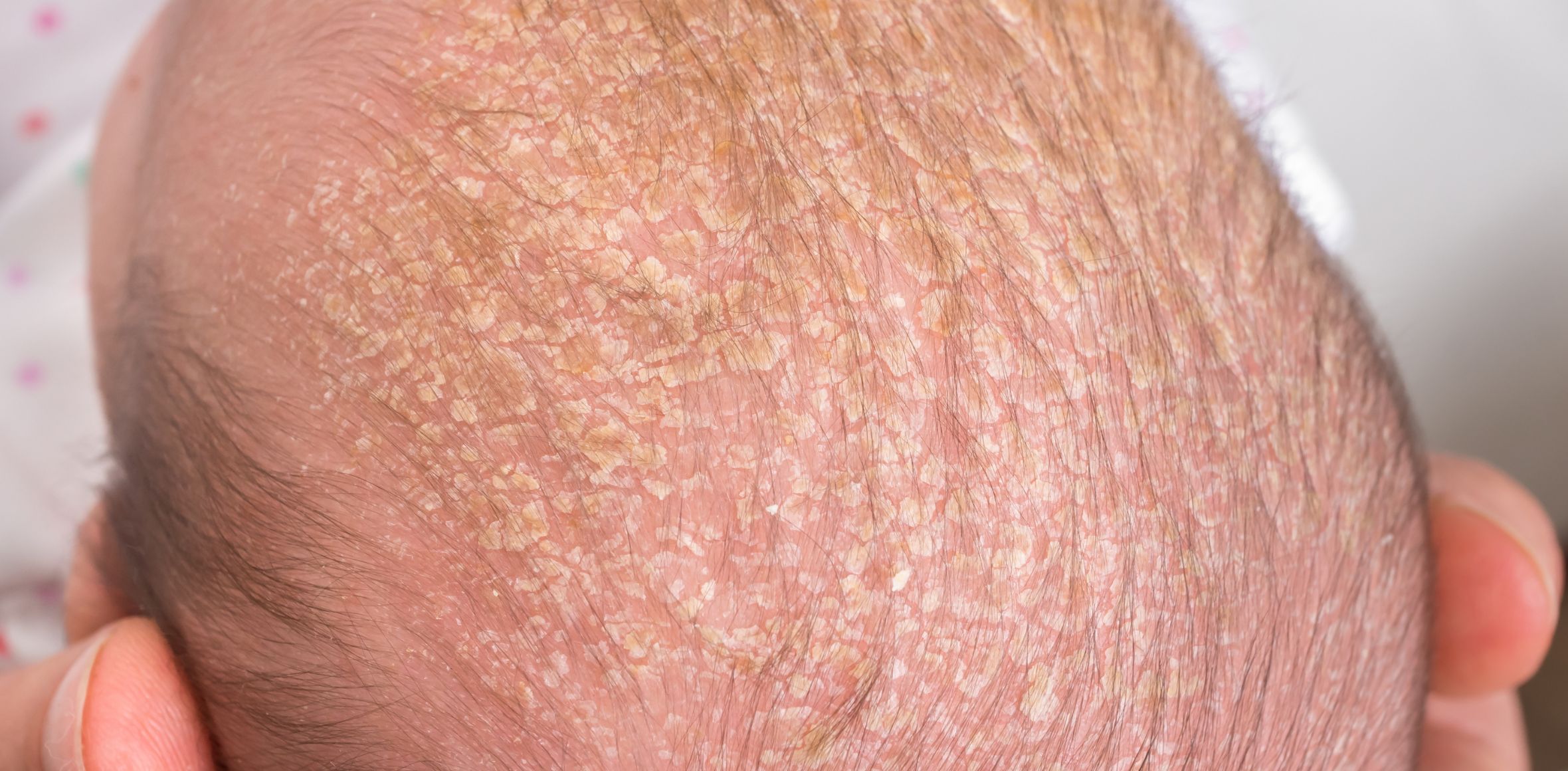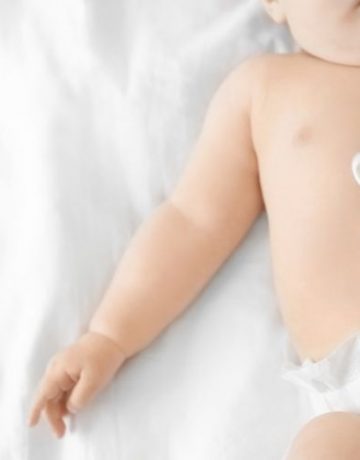Baby skin in the first weeks of life
This post was written by Dr. Pleimes, a specialist in pediatrics, dermatology and allergology
Click here to read further information about Dr. Pleimes.
The skin of a newborn baby differs in many ways compared to the skin of an adult. It is much more sensitive, thinner and not yet fully mature. Since the baby’s skin does not fully have all its protective functions, skin conditions can increase in the first months of life. In this article, you will learn which skin conditions are involved and whether they can be dangerous for your baby.

The sensitive skin of newborns
Although a large part of the development of babies’ skin takes place in the womb, many processes continue after birth. Especially in the first months of life, different adaptation processes have to take place to the sudden changes in the newborn’s environmental situation.
- From a moist environment of 100% amniotic fluid, the newborn is suddenly exposed to dry ambient air.
- At and after birth, various germs, including bacteria, yeasts and viruses, colonize the previously sterile skin.
- The acidity of the top layer of skin shifts to a slightly acidic range so that skin enzymes can work properly and protective skin germs can find a favorable environment.
Premature babies born before 32 weeks gestation have particularly immature skin, so without additional medical help, its function alone would often be insufficient to protect the body.
Children born at term also still have increasingly sensitive skin: the skin of newborns is still noticeably thinner than that of older children.
Impact of the sensitive baby skin
The uppermost layer of the skin, which consists of the horny cells, is even more irregularly layered than in older children. The underlying layers of the epidermis are also still very thin and the connection between the epidermis and the even deeper skin layers is not yet as stable as in older children. The latter leads to the fact that blisters can develop more quickly on the skin of newborns. For example, in the case of mechanical stress on the skin or in the case of skin infections or other skin diseases.
The sweat glands are also not yet fully functional and the temperature regulation of the newborn is more limited as a result. In addition to sweating, the amount of blood flow to the skin also has an effect on temperature regulation.
The thinner skin of the newborn makes fine vascular structures in the skin more visible. The fine skin vessels are also not fully developed at birth and still react differently to heat and cold stimuli. This can lead to a net-like pattern on the skin (the so-called marbling), which is more visible in a cool environment. It can also be an indication that a little more warmth would do your child good now.
The cheese smear (Vernix caseosa)

When newborns are born, they are usually surrounded by the cheese smear. This protective layer, also called vernix caseosa, consists of about 10% proteins, 10% fats and 80% water. Its presumed functions are:
- an additional protection of the skin during the transition from the humid environment in the amniotic fluid to the dry ambient air
- presumably also a protection during embryonic development against excessive moisture penetration by the amniotic fluid
- in addition, probably infection-preventing properties.
Skin discoloration in babies

The skin color of newborns can vary greatly. Among other things, age and temperature as well as skin color of the parents influence the appearance of the skin. Whether your baby cries or sleeps also makes a difference. Immediately after birth, skin often tends to be dark red to purple. After birth, when babies start breathing, the skin color changes to a shade of red. The red color of the skin then fades in the first days of life and the actual skin color comes to the fore.
Hands and feet may also remain partially bluish in color in some children. On these areas, this is usually a normal reaction. However, other parts of the body should not have blue skin color.
Some newborns develop yellowing of the skin as part of the normal renewal of blood cells. This occurs when red blood pigment is broken down and cannot yet leave the body quickly enough. Your midwife and the attending physicians will observe this during the first days of life and explain to you if there is a need to react. This is called jaundice or neonatal jaundice.
What happens to skin hydration after birth?

The moisture content of the baby’s skin initially decreases very rapidly after birth, only to increase again significantly over the next three months.
Especially in the first ten days of life, the particularly dry skin of newborns can also cause fine scaling of the skin on the entire body, but this is harmless and basically does not need to be treated. However, providing the skin with additional light care can alleviate this harmless phenomenon to some extent.
The protective acid layer of the newborn’s skin
The natural composition of the skin surface is in the slightly acidic range. The newborn’s skin adapts to this until the third month of life. This is particularly important for good functioning of the skin metabolism and for the correct composition of the skin microbiome, i.e. the good germs (primarily bacteria) that are supposed to live on the skin for our protection.
Fine hair on the baby skin
There may be small fine downy hairs on the newborn’s skin. Especially on the back and shoulders, but sometimes also on the face. They are also called lanugo hairs. Children who are born a little too early have these increased. These fine hairs will disappear by themselves in the course.
Your baby’s scalp is flaky?

Many babies develop an increased, often yellowish brown, usually somewhat tallowy scaling of the persistent scalp in the first weeks of life. It is also called cephalic gneiss. It consists of skin lipids and remnants of desquamated epidermal cells. Cephalic gneiss often has its own odor of sebum and skin fats. The scaling can be soaked gently with a bath oil or scalp gels or oils that remove dandruff, and removed with a mild shampoo when bathing. Rarely, bacteria can also multiply between the dandruff and a stronger odor or a weeping, purulent condition can then develop. You should then show this to your pediatrician.

In addition to cephalic gneiss, there is also the so-called cradle cap. Cradle cap and headgear are not always neatly separated from each other as terms. Cradle cap is actually a crusty inflammation of the skin, which often appears on the cheeks of infants and usually from the 2nd-3rd month of life. It is a sign of eczema, such as atopic dermatitis, and the same changes may also be present on the hairy scalp. In the case of cradle cap, the underlying inflammatory reaction may need to be treated by your pediatrician. In addition, the dandruff can be removed with a cradle cap gel or oil during bathing. Under the scales, however, there is usually a reddened/inflamed skin. If the redness is left, crusty findings easily develop again. In addition, itching develops more often in the course, which then leads to scratching and rubbing and can further damage the skin.
Red spots on the baby skin

Many newborns are already born with red spots on the skin, which are usually found on the neck and back of the head, sometimes also on the middle forehead, on the eyelids and more rarely along the spine. These are typically harmless dilatations of tiny, very superficial vessels, which are called stork bites. The stork bite on the face (e.g. in the middle of the forehead) usually recedes slowly during the first years of life, and may then only be seen when the child is excited. On the nape of the neck, the spots often remain, but are later no longer visible under the hair.

Small like stitch-like, red spots and pimples on the body can appear in some of the newborns in the first days of life. This is called neonatal exanthema or erythema toxicum neonatorum. It is a harmless rash that usually disappears by itself within the first two weeks of life and does not require treatment. The children are fine and appear awake and not sick. The exact cause of neonatal exanthema is not known. Reactions to the skin colonizing with germs or to the hormonal changes after birth are suspected.
Pimples, blackheads and co. on babies
Milia

Many newborns are born with small white spots or tiny whitish nodules on the face, usually only 1 mm in size. These are so-called milia. These are small balls in the upper layer of the skin with sebum trapped inside. They are harmless and usually disappear by themselves in the first year of life.
Enlarged Pores

The nose of newborns often shows enlarged pores. These are still active and therefore enlarged sebaceous glands. They still had to work more in the last third of pregnancy, also to produce the cheese smear for your baby. They are harmless and regress during the first months of life.
Acne like skin
In the first month, more subunits and pimples may develop on the skin, especially on the face of the newborn. Although this is usually referred to as newborn acne, different causes are hidden behind the small pimples. Real acne is probably rarer than a reaction of the skin to colonization with yeasts (hair follicle inflammation due to Pityrosporum colonization) or an excessive inflammatory reaction of the areas rich in sebaceous glands (seborrheic dermatitis) such as the face. In all these reactions small pimples, sometimes also yellowish filled pustules can develop. However, only in the case of true neonatal acne does the appearance of additional blackheads (comedones) occur.
All three skin changes have in common that strongly oily creams, ointments or oils for care can worsen the findings on the face. In this case, a switch should be made to light and primarily water-based skin care products. On older infants from about the third to fourth month of life, the pimples have usually disappeared by themselves and dry skin findings then predominate. In this case, treatment can usually be somewhat richer, i.e. with a higher fat content in the cream.
Proper care for baby skin
On the one hand, the skin of newborns and even younger children is increasingly sensitive and permeable, and on the other hand, the body surface area is also significantly larger in relation to body weight than in older children. Both of these factors lead to increased absorption into the body of substances applied to the skin. In cosmetics, skin washes or sun creams used on children, any kind of questionable ingredients and unnecessary additives should therefore be avoided. You can find more information on the proper care of babies’ skin here.





Comments (0)